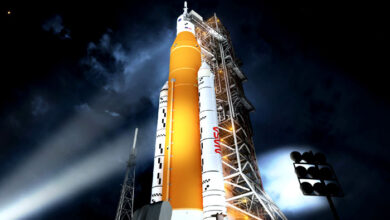NASA’s rock-hunting rover exposes the unusual geology of a Martian crater.

(Reuters) – Washington, U.S.: Core samples excavated on the Martian surface by NASA’s Perseverance rover are revealing the geology of a huge crater that scientists say may have hosted microbial life billions of years ago, including discoveries about the composition of the rock there.
The samples, collected by the car-sized, six-wheeled robotic rover and kept for future transmission to Earth for additional examination, revealed that rock from four locations inside Jezero crater is igneous, meaning it was produced by the cooling of molten material. The rocks also showed indications of water-induced alteration, indicating that cold and arid Mars was once warm and moist.
The scientists assumed the rock, which originated around 3.5 billion years ago, was sedimentary, produced when mud and sand settled on a lakebed.
“In fact, despite the knowledge that the crater originally housed a lake and material must have been deposited, we found no trace of sedimentary rocks when the rover examined the crater floor. Those sedimentary layers have to have eroded. ” Caltech geochemist Kenneth Farley is the primary author of one of four articles explaining the geology of the crater, published in the journals Science and Science Advances.
Perseverance landed on Mars in February 2021 and has been hard at work in Jezero crater ever since, employing a set of equipment to investigate if Earth’s nearest planetary neighbor has ever had circumstances favorable to life.
It is collecting rock samples the size of blackboard chalk in little tubes that will be recovered by a spaceship in 2033 and sent to Earth for additional analysis, including biosignatures—signs of life.
The Jezero crater is 28 miles (45 kilometers) wide and located slightly north of Mars’ equator. The area appears to have been rich in water and home to a river delta, with river channels pouring over the crater rim to form a vast lake. Scientists believe the crater may have been home to microbial life, with evidence that may be found in a lakebed or shoreline rock.
Perseverance is currently gathering samples in the delta area.
The crater’s igneous rocks were discovered to have reacted with water, forming new minerals and depositing salts. However, this water was either scarce or did not last long—most likely groundwater. The existence of water, however, shows that this was a livable environment at the time, according to the experts.
“We collected samples that will be returned to Earth, and they should provide critical evidence of what kinds of organisms, if any, inhabited the Jezero crater floor rocks when they were interacting with water,” said Yang Liu, lead author of one of the studies and a planetary sample scientist at NASA’s Jet Propulsion Laboratory.
The four samples were taken from two different locations, Seitah and Maaz. Selah rock appears to have developed underground as a result of the gradual cooling of a thick sheet of lava. The Maaz rocks may have cooled faster in an upper layer of subterranean magma or following a volcanic surface eruption. In any case, whatever rock layer that originally covered these places has been worn away by water or wind.
The Seitah samples, according to Liu, are coarse-grained igneous rocks containing the mineral olivine, and three Martian meteorites discovered on Earth have a similar composition.
Examining the samples on Earth may indicate when the rock was produced and provide a more certain answer to when liquid water was on Mars’ surface. Water is an essential component of life.
“Understanding when, and for how long, the climate conditions on Mars allowed for the stability of liquid water is critical to the larger questions that we are attempting to address with this mission and sample return—on whether and when life could have once existed on early Mars, billions of years ago,” said the University of California, Berkeley geochemist and study co-author David Shuster.





